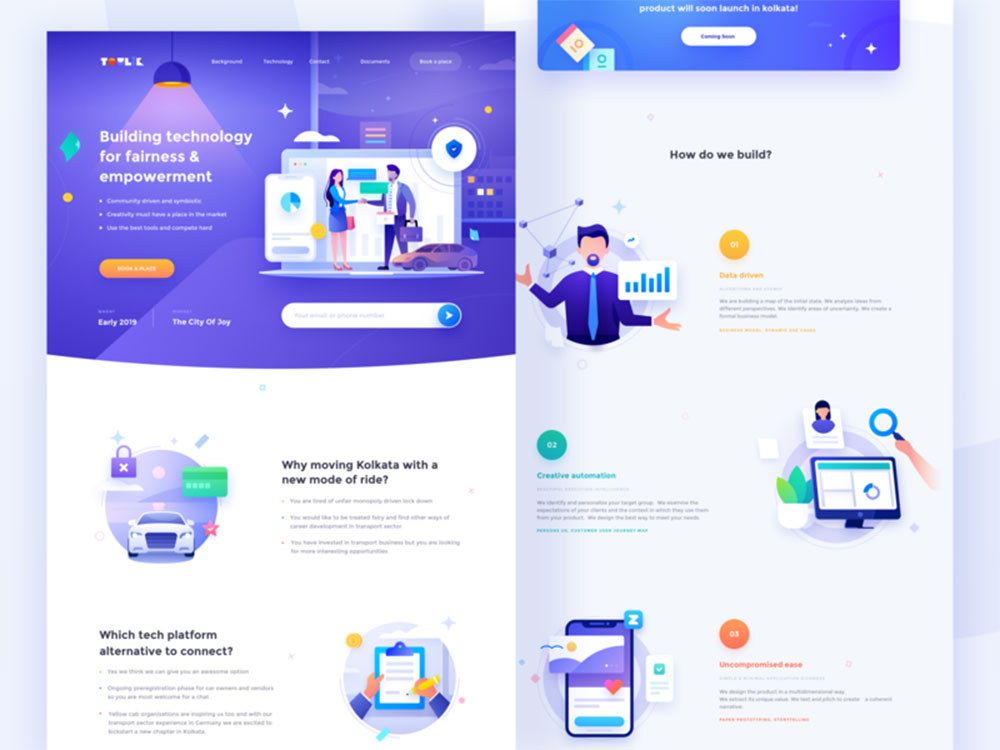From Courtroom to Website: Crafting Client-Centered Designs for Family Law Attorneys

The family law courtroom can be an emotionally charged and complex place. While lawyers offer legal guidance, clients may still feel overwhelmed by the process. A well-designed family law firm website can offer understanding, trust, and reassurance when clients need it most.
Traditional marketing often lacks the sensitivity needed to connect with family law clients. Generic approaches can feel impersonal during times of crisis. This is where client-centered web design shines – it creates a welcoming and informative online space for potential clients.
Consider a website that anticipates clients’ anxieties rather than simply listing legal services. Warm visuals, calming colors, and easy-to-understand language replace confusing legal jargon. Clear explanations of complex topics, accessible FAQs, and downloadable guides written in plain language are essential. Showing compassion and understanding that you’re here to help is more important than just designing.
This approach translates to better client experiences and tangible business growth. Studies show that empathetic websites attract more clients and keep them engaged. When clients feel understood, they’re more likely to reach out, trust your services, and recommend you to others. A dedicated testimonials section or a blog series focused on the emotional side of family law further highlights your commitment to client well-being.
Understanding the Client
Divorce papers feel like a punch to the gut, child custody battles leave you emotionally drained, and every decision carries the weight of futures reshaped. Fear, sadness, and uncertainty accompany you on this emotional rollercoaster that isn’t just a legal maze.
Now, consider your website as a handhold amidst this maelstrom. When a client first lands on your page, what emotions do they encounter? Do they see sterile corporate landscapes or do they see images that resonate with their lived experience? Think of warm family moments, calming nature scenes, or gentle illustrations that convey support and understanding. Remember, visuals speak volumes, and in this arena, empathy should be your loudest voice.
Beyond the soothing aesthetics, consider the information clients crave. You’re more likely to lose trust if you use legalese, rather than clear explanations, accessible language, and FAQs that address their concerns.
How long does a divorce typically take? What happens to child support during custody battles? These are the questions that keep clients awake at night, and your website should be the comforting voice that dispels shadows with straightforward answers.
An effective lawyer web design anticipates client emotions as well as catering to them. Think blog posts tackling common anxieties, downloadable guides on navigating the legal process, and even videos with lawyers offering reassuring words. Your website becomes a resource center, a virtual handhold through the emotional labyrinth, and ultimately, a testament to your genuine commitment to their well-being.
Let’s face it, legal documents hold little comfort for someone grappling with emotional upheaval. So, let your website be the antithesis of legalese. Craft visuals that whisper understanding, design layouts that guide with intuitive ease, and fill your content with clear, reassuring language. A website can be more than just an online brochure when you truly understand the client journey. In times of difficulty, it can be a friend who walks alongside them.
Designing for Clear Communication and Accessibility
User-friendly navigation is the first step. Think intuitive menus, clearly labeled buttons, and a search bar that works. Avoid adding to your client’s emotional turmoil by making their navigation of your digital maze difficult. Keep it simple, intuitive, and accessible across all devices. Your website should work seamlessly on smartphones, tablets, and desktops, catering to clients on the go or seeking solace at home.
The need for mobile responsiveness goes beyond buzzwords. Studies show that over half of legal website visits come from mobile devices. So, ensure your website adapts flawlessly to smaller screens, offering the same clear information and easy navigation as its desktop counterpart. Don’t leave clients squinting and zooming – make their digital journey smooth and effortless.
Now, let’s talk in plain language. Legal jargon might impress your peers, but it alienates clients already feeling vulnerable. Use clear, concise language that explains complex legal concepts in everyday terms. Break down confusing legalese, avoid dense paragraphs, and embrace bullet points and infographics. Remember, your website should be an informative resource, not a legal dissertation.
Accessibility goes beyond mobile-friendliness. Make sure your website adheres to WCAG (Web Content Accessibility Guidelines) standards. This includes features like alt text for images, screen reader compatibility, and adjustable font sizes. By catering to diverse needs and abilities, you ensure your website welcomes everyone, not just a select few.
Creating a user-friendly, accessible website isn’t just about being nice; it’s about building trust and establishing credibility. Clients who can navigate your website with ease and find the information they need are more likely to reach out and become loyal clients. So, ditch the design jargon and embrace clarity. Remember, in the courtroom of family law, understanding is your most potent weapon. Design a website that bridges the gap, not widens it, and watch trust and connections flourish.
Content that Builds Trust and Answers Concerns
Addressing common family law queries directly on your website isn’t just informative; it’s a compassionate act. Whether it’s “What happens to my child custody during the divorce process?” or “Can I protect my financial assets?”, acknowledging and answering these anxieties head-on shows you understand their concerns. Consider creating FAQs sections and downloadable guides on topics like divorce procedures, child custody options, or prenuptial agreements. Offer free consultations or video explainers to further bridge the information gap.
But information alone isn’t enough. People dealing with family law issues need reassurance, a testament to your expertise and success. This is where client testimonials and success stories come in. Showcase real-life experiences, highlighting how you’ve helped individuals navigate similar challenges. Let satisfied clients speak for you, weaving narratives of empathy, resolution, and positive outcomes. Testimonials aren’t just marketing tools; they’re human testaments, building trust and solidifying your position as a reliable guide in their time of need.
Web Design as a Marketing Tool
Client-centered design isn’t just a feel-good concept; it’s a strategic family law marketing weapon in the digital battleground of family law. When you prioritize clarity and empathy, you’re not just building trust; you’re paving the way for lead generation and client retention. Here’s how:
SEO (Search Engine Optimization): Remember, clients seeking legal help aren’t scrolling through Yellow Pages; they’re searching online. By incorporating relevant keywords, FAQs, and clear explanations of your services into your website content, you’re increasing your visibility in search engine results. Imagine someone Googling “divorce attorneys Chicago” and your website, oozing empathy and information, pops up first. That’s the power of SEO-optimized client-centered design.
Social Media Savvy: Your website isn’t an island; it’s a hub for building community and engagement. Share informative blog posts, client testimonials, and even uplifting stories related to family law on your social media platforms. Use Facebook Groups or Twitter Q&A sessions to create safe spaces for people to ask questions and feel heard. By leveraging your website’s content and fostering positive online interactions, you’re nurturing leads and building lasting relationships with potential clients.
Content that Converts: Remember, website content isn’t just legal jargon; it’s a conversation starter. Offer blog posts that address common concerns like “5 Questions to Ask Before Filing for Divorce” or “Navigating Child Custody with Compassion.” These engaging pieces not only showcase your expertise but also attract website visitors who are actively seeking help, increasing your conversion rate. Think of it as offering a virtual handhold through the family law maze, drawing potential clients closer to your services.
Don’t forget, that this isn’t a one-time marketing sprint; it’s a marathon of continuous improvement. Monitor your website analytics, track social media engagement, and adapt your content and strategies based on data insights. It’s important to stay tuned in to your audience, so you can provide understanding and support to them not just through legal advice, but also in life’s most challenging situations.
Conclusion
It’s time to rewrite the narrative of family law websites. They needn’t be sterile repositories of legalese; instead, they can become sanctuaries of understanding, guiding lights in the storm of emotional upheaval. Embrace client-centered design, and create more than just a website – build a bridge of support and understanding for those facing the challenges of family law.
And to embark on this journey with confidence, remember, resources abound. Explore industry-specific Chicago web design communities, attend webinars on legal marketing, and connect with fellow legal professionals who champion the power of empathy in online spaces. You’ll find a wealth of inspiration, practical tips, and a supportive community ready to help you design a website that offers clients trust and understanding.
In the grand courtroom of the digital landscape, let your website stand out as a champion of human connection. Design with empathy, guide with clarity, and witness the power of client-centered design to transform your online presence into a force for good in the lives of those navigating the complexities of family law. The web awaits, and your clients – your future advocates – deserve a website that truly understands them. Now, go forth and design, dear lawyer, and watch your digital bridge illuminate the path toward hope and resolution.
- The GlaxoSmithKline Logo History, Colors, Font, And Meaning - 1 July 2024
- PT to PX Converter - 1 July 2024
- The Johnson & Johnson Logo History, Colors, Font, And Meaning - 30 June 2024









